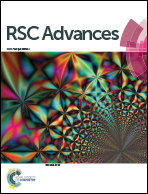Distinct mechanical properties of nanoparticle-tethering polymers†
Abstract
Mechanical properties of nanoparticle-tethering polymer systems were investigated by molecular dynamics simulations. The stress–strain behavior of nanoparticle-tethering polymers as a function of interaction strength and architecture parameters (polymer length and particle size) was examined. As the interaction strength between nanoparticles and polymers increases, the stress increases. The effects of architecture parameters on the stress are relatively complicated. With decreasing polymer length or increasing particle size, the stress increases at smaller strain, while at larger strain, the stress first increases and then decreases. The tensional moduli were also found to be dependent on the interaction strength and architecture parameters. The nanoparticle-tethering polymers exhibit enhanced mechanical properties relative to neat polymers and nanoparticle/polymer blends. It was found that the bond orientation, bond stretching, and nonbonding interaction play important roles in governing the mechanical properties of the nanoparticle-tethering polymer systems. The simulation results were finally compared with available experimental observations, and an agreement was obtained. The results gained through these simulations may provide useful guidance for designing high-performance hybrid materials.


 Please wait while we load your content...
Please wait while we load your content...